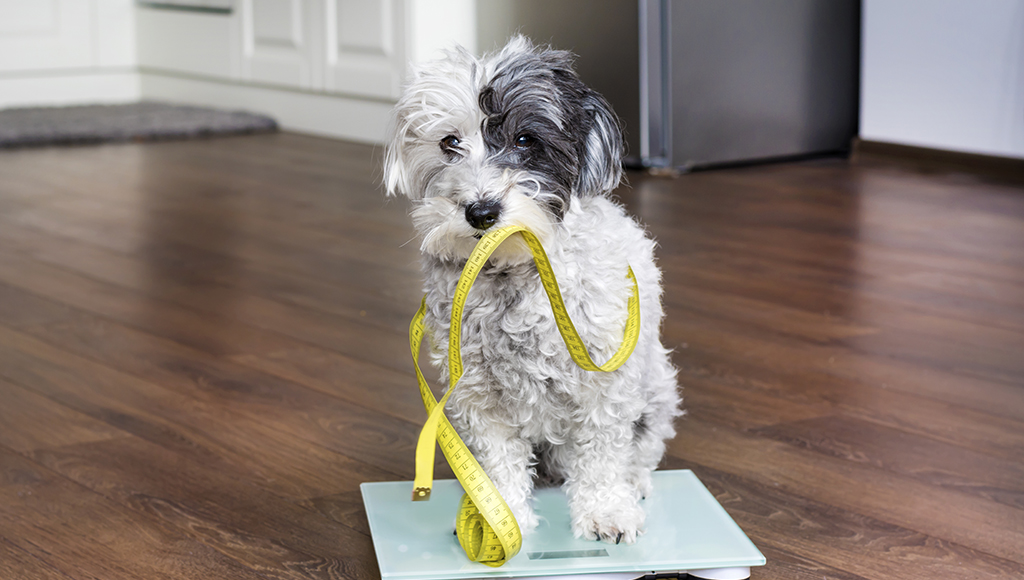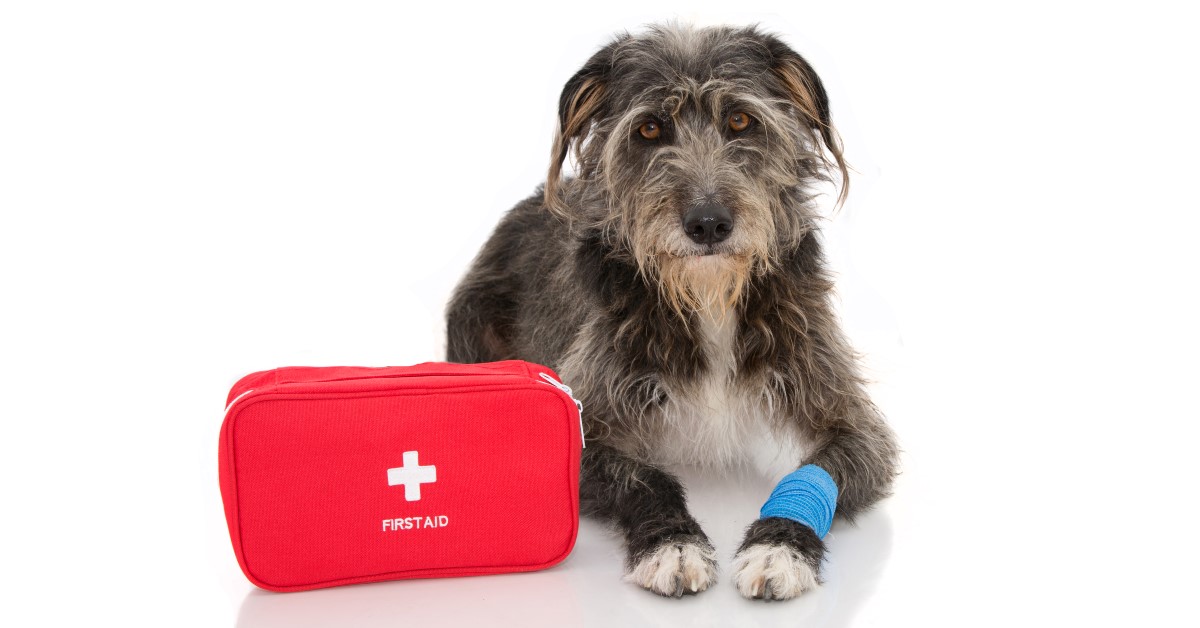A Growing Problem: Pet Obesity
With so much evidence about the harm those extra pounds cause pets, let’s delve into why so many pets are overweight, how to evaluate your pudgy pal’s body condition, and how to keep your pet trim and healthy.

According to the Association for Pet Obesity Prevention (APOP), over half of the nation’s pet population is overweight or obese. Their latest survey results from 2018 classified 55.8% of dogs and 59.5% of cats as overweight or obese. Fortunately, these numbers stayed relatively stable from the year prior, but that is still a massive number of extra pounds piled on our pets. Although we’ll admit chubby kitties and pudgy pooches are adorable—all the more to love—this growing problem needs to be addressed. After all, the link between obesity and many diseases has been heavily researched in human medicine, and much of that carries over to veterinary medicine. With so much evidence about the harm those extra pounds cause pets, let’s delve into why so many pets are overweight, how to evaluate your pudgy pal’s body condition, and how to keep your pet trim and healthy.
Why are pets likely to become obese?
It’s no secret that American pets are pampered fur babies. However, one of the most common ways people spoil their pets is through an overabundance of tasty treats. Whether these treats are commercially produced for pets or they come from the table or potato chip bag, too many snacks are often given as a way to show pets love. In addition to a bounty of treats, there are a variety of reasons pets are overweight, including:
- Busy families may not have time to adequately exercise their pets. Most dog breeds require more activity for their mental and physical health than a quick stroll around the block twice a day.
- Many pets are free-fed and have access to a buffet of food all day long. Meals should be measured out, rather than filling a bowl.
- Pet owners may feel guilty about not spending enough time with their furry companions, and offer treats to assuage guilty feelings. For example, pets may receive treats before their owners leave and another one upon returning. However, it’s an excellent idea to offer your pet a long-lasting treat when you leave for the day to keep them entertained—just monitor the calories.
- Pets receive treats for any number of reasons, such as coming in from outside, before bed, and when the owner is eating a snack. All too often, this practice exceeds the recommended 10% daily amount of calories from treats.
- Many commercial treats are high in fat and sugar, which equates to feeding your pet junk food. While these treats are fine on a limited basis, there are much healthier options for tasty snacks for your furry pal.
While it may be tough to avoid your pooch’s puppy-dog gaze while you fry up bacon, avoid overdoing it on treats high in fat, sugar, and calories. With so many healthier alternatives available, you can help keep your four-legged friend healthy and reduce their risk for a multitude of weight-related diseases.
How does obesity harm my pet’s health?
Since people suffering from obesity combat chronic fatigue, malaise, decreased energy and vitality, and numerous aches and pains, it makes sense that overweight pets feel the same way. In addition to feeling poorly, pets with obesity are more likely to develop a variety of health issues, including:
- Diabetes and insulin resistance
- Respiratory conditions
- Heart disease
- Hypertension
- Kidney disease
- Arthritis and joint problems
- Cancer
The main problem with obesity is actually not the fat; it’s the chronic, systemic inflammation created by the adipose tissue. Chronic inflammation is the root cause for many health conditions, even cancer. Although studies in cats and dogs are currently lacking, the connection between laboratory animals, humans, and cancer is clear. Fortunately, these diseases can often be prevented by proper nutrition, an active lifestyle, and maintaining a healthy weight.
How can I determine my pet’s body condition score?
Like with people, the number on the scale is not the best indicator of health for pets. Instead, have your veterinarian show you how to evaluate your pet’s body condition score. An ideal body condition for cats or dogs is demonstrated by the ability to feel their ribs under light pressure, an hourglass figure when viewed from above, and an abdominal tuck when viewed from the side. For images depicting the body condition score charts for pets, check out the graphics produced by the World Small Animal Veterinary Association (WSAVA).
How can I help my pet reach and maintain an ideal weight?
Although it’s tough to stick to a diet and exercise plan, for pets and people alike, follow these five tips to help your furry pal reach and maintain an ideal weight:
- Calculate calories — Don’t blindly follow the feeding guidelines on your pet’s food bag. Those guides are formulated for adult, intact, active pets, which the majority of the pet population is not. If you follow these guidelines, you’re likely feeding 20% to 30% too much. Instead, try out this handy cat or dog calorie calculator, or ask your veterinarian to calculate the daily number of calories your pet needs.
- Measure meals — Use an actual measuring cup—not the mega cup from your gas station—for measuring out your pet’s meals. Once you’ve determined how many calories per day your furry pal needs, divide that number into at least two meals, then measure out the appropriate portion based on the calories in each cup.
- Choose healthy treats — Many commercial pet treats are chock-full of sugar and fat, which makes them especially appealing to cats and dogs. However, it’s similar to feeding your four-legged friend a candy bar with every treat. Opt for low-calorie, no-sugar snacks instead. Fresh veggies, such as carrots, broccoli, zucchini, and green beans are excellent treat options for dogs, while cats will appreciate a small flake of grilled tuna or salmon.
- Exercise daily — Daily aerobic activity is a vital part of living a healthy, pain- and disease-free life, for pets and people alike. For dogs, as little as half an hour of brisk walking will boost immune function, improve cardiovascular health, and reduce many behavioral problems. The best part of having a dog is that you have a built-in exercise buddy who’s begging for a jog every day. Cats are a bit trickier to exercise, unless your feline friend is harness-trained. Otherwise, try playing with a remote-controlled mouse, laser pointer, cardboard-box fort, or crumpled balls of paper for 15 minutes per day.
- Add fat-fighting supplements — Daily omega-3 fatty acid supplements pack a powerful antioxidant punch that has been proven to help prevent and treat numerous diseases. These supplements can also reduce inflammation and encourage weight loss. L-carnitine has also been shown to aid weight loss and promote lean muscle mass. Before adding supplements to your pet’s diet, speak with your veterinarian to ensure they’re safe for your furry pal’s condition.
Shedding extra pounds can be a long, slow process, but adding years to your pet’s life and reducing their risk for a variety of health conditions is worth the battle. If you need additional help, enlist the aid of your veterinarian for calorie calculations, prescription weight-loss diets, and body condition evaluations. With dedication and perseverance, you can find your chubby pet’s waistline again.
Ready to start saving money on pet wellness care?
Then take a look at Mint Wellness, the pet wellness plan that provides fast reimbursement on routine pet care. Save on vaccinations, wellness exams, preventatives, dental, and more!
Learn More


